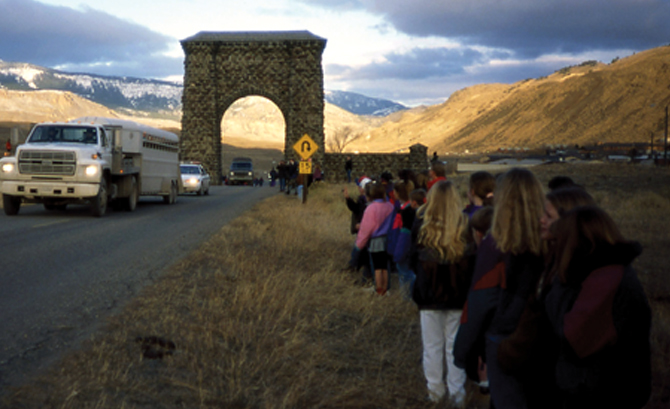
“Wolves arrived in Yellowstone National Park via truck on January 12, 1995,” according to the National Park Service.
SODA BUTTE, Yellowstone National Park — “The alpha female has averted her tail.”
“Looks like it’s not the right moment.”
“Nope, the alpha male isn’t showing much interest. He’s wandered off.”
Chronicling the sex lives of gray wolves in February combines a strange mix of clinical jargon, voyeurism and hypothermia along the side of Highway 212. Hours of toe-numbing patience watching the Lamar Canyon Pack lounge under a grove of pine trees turns into a paparazzi stampede when the wolves suddenly rise and lope across a brushy hillside.
A dozen human observers collapse their tripods and stuff their spotting scopes and cameras into cars before scooting around a corner to keep the pack in view. As the wolves file toward the ridgeline, someone calls out that a subordinate male is making his move on the alpha female.
“For me, February is the most intense time of the year,” said Rick McIntyre, Yellowstone Park’s longtime wolf biologist. “But it’s always worth it. You just have to put in the hours and catch up on your sleep after it’s over.”
For 17 years, McIntyre has been getting up before dawn and enduring the cold past dusk to learn what he can about Yellowstone’s wolves. This February, he and an informal band of colleagues witnessed 202 “ties,” or breeding incidents, among the several packs that hunt along the highway corridor.
The Lamar Canyon Pack’s alpha female descends from Yellowstone wolf royalty. She claims two of the original Rose Creek Pack members — one of the first transplanted wolf packs in Yellowstone back in 1994 — as fifth-generation ancestors. Wolf 21, widely considered the most famous and storied character in Yellowstone wolf history, was her great-grandfather. She’s the daughter of the ’06 Female, who was famously killed by a hunter in Wyoming’s first wolf hunt in 2012. She’s probably using a den originally occupied by her great-grandmother, a member of the well-chronicled Druid Pack.
Wolf researchers know all this because of Highway 212 — the road between Gardiner and Silver Gate across Yellowstone’s northern tier that’s plowed year-round. It’s the only route accessible by automobile in winter, giving observers unparalleled opportunities to monitor daily life in the wild.
“It’s especially difficult to see mating behavior,” McIntyre said. “Most of what we know comes from wolves in captivity, which is not representative.”
For example, researchers long assumed a pack’s alpha male was responsible for all the fathering. It appears that holds true only half the time in the wild, where subordinate males often get their genes in the mix.
Alpha females, in turn, breed only about 43 percent of the time each year. Subordinate females also get bred, resulting in a few males and females breaking off to form new packs.
“I’ve tried to specialize in breeding behavior,” McIntyre said. “Over 17 winters, I’ve seen a lot of variation in what can happen during breeding season. This year has the least snow and the warmest temperatures I’ve seen. One morning in February, it was 52 degrees at Soda Butte.”
Choosing partners
A little farther down the road shoulder, Steve Maras was sharing his telescope eyepiece with a new wolf-watcher.
“I try to come up here about six times a year,” said Maras, a distinctively tall man in a Montana State University Bobcat jacket and furry hat. “This is my 15th year coming up from Colorado. It’s my hobby — one of those things you just can’t stop doing once you start.”
Maras’ generosity has left such an impression on the newcomers, one of them had returned with a big stuffed wolf toy as a thank-you gift. He placed it with pride on the dashboard of his truck.
Source: Mating on the move: Wolf watchers convene for Yellowstone breeding season | Outdoors | helenair.com
